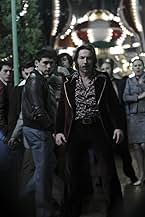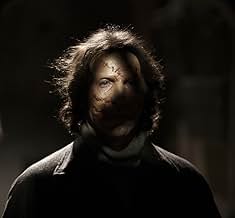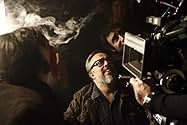IMDb रेटिंग
6.5/10
16 हज़ार
आपकी रेटिंग
अपनी भाषा में प्लॉट जोड़ेंA young trapeze artist must decide between her lust for Sergio, the Happy Clown, or her affection for Javier, the Sad Clown, both of whom are deeply disturbed.A young trapeze artist must decide between her lust for Sergio, the Happy Clown, or her affection for Javier, the Sad Clown, both of whom are deeply disturbed.A young trapeze artist must decide between her lust for Sergio, the Happy Clown, or her affection for Javier, the Sad Clown, both of whom are deeply disturbed.
- पुरस्कार
- 11 जीत और कुल 21 नामांकन
Alejandro Tejerías
- Motorista-fantasma
- (as Alejandro Tejería)
Sasha Di Bendetto
- Javier (Niño 1937)
- (as Sasha Di Bendetto)
फ़ीचर्ड समीक्षाएं
After the really disappointing "Oxford murders", Álex de la Iglesia returns with not only his best film to date, but with one of the best films in the last years. "Balada Triste de Trompeta" is a romantic-over the top-violent melodrama which mixes Tarantino, Hitchcock, Fellini, Todd Browning and of course it also has a lot of previous Álex de la Iglesia films like "Acción Mutante" or "El día de la bestia". Two men, one good and one bad, fighting for the love of a beautiful blonde trapeze artist (the gorgeous Carolina Bang) in a downward spiral of love and madness that also serves as a historical recount of the last 75 years of Spanish history.
The first reaction I had to this film was - "an overkill". So much gore and blood in a small love triangle story, seemed excessive. But my very next thought was, I must be missing something. And as I went over the perfectly designed gory details of the movie one more time in my mind I realized I was watching a surreal fable on the fate of Spain from the Spanish civil war onward. The only proof of that claim I can give here without adding a spoiler is the fact that the opening scene of the film takes place in 1937 while most of the story happens on 1973, but there's no logical base for such a big time gap, the only reason these two dates were chosen is because the second is the mirror image of the first, and they both fit into the historic background necessary for the story.
As a fable, we have all the right ingredients of a fable in, the characters may be slightly flat, since their symbolic value is more important than their personality but the actors make it work anyhow.
So if your stomach can take gore and blood in quantities that would suit a horror movie, and you're interested in an original point of view on the destiny of Spain in the 20th century - it's definitely worth seeing
As a fable, we have all the right ingredients of a fable in, the characters may be slightly flat, since their symbolic value is more important than their personality but the actors make it work anyhow.
So if your stomach can take gore and blood in quantities that would suit a horror movie, and you're interested in an original point of view on the destiny of Spain in the 20th century - it's definitely worth seeing
To watch this movie and enjoy it one must suspend all judgment.
It doesn't pretend to show us scenes of everyday living, or the girl next door shopping at the supermarket.
It deals with the same magic world that García Márquez deals with in his exotic novels. Marvellously created world. As thrilling as any Fellini movie. The circus world is the perfect setting for developing this view, between fantasy, nightmares and awful reality.
The pacing is relentless, a thousand things happening during the 120 minutes or so, all of them linked within the main story and showing a whole range of human emotions among the three main characters: The Smiling Clown, The Sad Clown (his sidekick) and the beautiful trapeze girl, the object of jealousy, fury, rancor between the two clowns.
Every scene is visually baroque in essence, since action takes place in the foreground but also in the background, with secondary characters.
There is a full color palette, dazzling as an old kaleidoscope making all sorts of beautiful patterns that change in front of our eyes delighting us continuously.
The acting is superb, from the principal actors to the last extra. The delivery of the lines in Spanish is done at full speed, clean as a whistle and sharp as a cracking whip by all the actors.
The digital effects perfect. Top entertainment from beginning to end. What a SEN-SA-TION-AL movie!!!
It doesn't pretend to show us scenes of everyday living, or the girl next door shopping at the supermarket.
It deals with the same magic world that García Márquez deals with in his exotic novels. Marvellously created world. As thrilling as any Fellini movie. The circus world is the perfect setting for developing this view, between fantasy, nightmares and awful reality.
The pacing is relentless, a thousand things happening during the 120 minutes or so, all of them linked within the main story and showing a whole range of human emotions among the three main characters: The Smiling Clown, The Sad Clown (his sidekick) and the beautiful trapeze girl, the object of jealousy, fury, rancor between the two clowns.
Every scene is visually baroque in essence, since action takes place in the foreground but also in the background, with secondary characters.
There is a full color palette, dazzling as an old kaleidoscope making all sorts of beautiful patterns that change in front of our eyes delighting us continuously.
The acting is superb, from the principal actors to the last extra. The delivery of the lines in Spanish is done at full speed, clean as a whistle and sharp as a cracking whip by all the actors.
The digital effects perfect. Top entertainment from beginning to end. What a SEN-SA-TION-AL movie!!!
A magic tale of terror, dark humour and tragedy!! I think that this film is like a mix of Rodrigues, Jarmush and Kusturica... gripping and strong whilst dark, random and ghastly at the same time. Romantic and disgusting in one film. de la Iglesia beautifully makes the whole film look like a circus performance with all characters exaggerated to the point that even Franco looks like a clown. Though I appreciate that this film is probably not for everyone, I think that it's an original and interesting portrayal of, amongst other things, love and war during horrors of Spanish civil war - an interesting contrast to del Toro's "El Labiirinto del Fauno"!
"Balada triste de trompeta" (Sad trumpet ballad, in Spanish -I have no idea why they translated it as "The last circus", as it's much poorer) is none short of a masterpiece, in my opinion. It is also a 100% Spanish film, meaning it is a tragicomedy, a totally Spanish genre and it also expands between two crucial moments of Spain's recent history, full of tragic events -the Civil War, the killings, Franco's repression and dictatorship- but also full of grotesque details, situations and characters that were real and now, in retrospect, feel utterly ridiculous, much more so than they were at the time -e.g. when the dictator went hunting, they really prepared the prey for him so that he would look as a great hunter- or are just seen as a byproduct of the times that Spain had to live. Director Alex de la Iglesia also cares to sprinkle the movie with historical events that are apparently disconnected to the main story -like the assassination of Franco's hard man and presumed heir as the new tyrant, admiral Carrero Blanco- but which I believe serve a function to the main metaphor that this movie is.
The movie starts in 1937, in the heat of the Spanish Civil War. A clown is recruited by force to fight with the Republican side, and manages to slaughter quite a lot of Franco's men. His young son, Javier, is traumatized by the whole event and later, in 1973, we meet him again as the new recruit in a circus, the Sad Clown. He can only be the sad clown because he is sad himself, and cannot make children laugh. They pair him up with the Funny Clown, a ruthless but charismatic man called Sergio, who turns out to be the partner to a beautiful trapeze artist, Natalia. Javi falls in love with Natalia and thus starts a rivalry between the two men for the love of a woman, with unforeseeable consequences.
The narration is so filled with colorful characters, crazy comedy, crazy violence mixed with comedy or with surreal elements, historical references, and an underlying sense of tragicomedy, and it is so excessive and full of surprises, one can't help but keep watching, much as it is over the top in many an occasion. You can enjoy the movie at face value and ride the wave of the story for what it is, but you can also watch this movie as a summary and insight into the recent Spanish history and how Spain seems doomed to always be split in two, similar people, brothers, always rivalling and even hating each other, seemingly beyond reconciliation, connecting episodes of sheer senselessness and absurdity with spine-chilling episodes of hate and violence, and all of it boiling down to a tragedy that you can only laugh at because it makes no sense.
I'm not surprised that Quentin Tarantino himself was so taken with this movie, and I wouldn't be surprised if an adaptation of this movie was made soon in an American context.
The movie starts in 1937, in the heat of the Spanish Civil War. A clown is recruited by force to fight with the Republican side, and manages to slaughter quite a lot of Franco's men. His young son, Javier, is traumatized by the whole event and later, in 1973, we meet him again as the new recruit in a circus, the Sad Clown. He can only be the sad clown because he is sad himself, and cannot make children laugh. They pair him up with the Funny Clown, a ruthless but charismatic man called Sergio, who turns out to be the partner to a beautiful trapeze artist, Natalia. Javi falls in love with Natalia and thus starts a rivalry between the two men for the love of a woman, with unforeseeable consequences.
The narration is so filled with colorful characters, crazy comedy, crazy violence mixed with comedy or with surreal elements, historical references, and an underlying sense of tragicomedy, and it is so excessive and full of surprises, one can't help but keep watching, much as it is over the top in many an occasion. You can enjoy the movie at face value and ride the wave of the story for what it is, but you can also watch this movie as a summary and insight into the recent Spanish history and how Spain seems doomed to always be split in two, similar people, brothers, always rivalling and even hating each other, seemingly beyond reconciliation, connecting episodes of sheer senselessness and absurdity with spine-chilling episodes of hate and violence, and all of it boiling down to a tragedy that you can only laugh at because it makes no sense.
I'm not surprised that Quentin Tarantino himself was so taken with this movie, and I wouldn't be surprised if an adaptation of this movie was made soon in an American context.
क्या आपको पता है
- ट्रिवियाAccording with Álex de la Iglesia, Raphael watched the movie before the public premieres, and he didn't like voice acting of the actor who played him. De la Iglesia offered him to dub himself, and finally is Raphael's voice which is heard in the movie.
- गूफ़When Andres is arrested, he says "maderos" to the policemen, but this word was not yet used at this time. He shoould have said "grises" (grey) because this is the color of the police uniform - only years later would it become brown. ("Madero" is log or piece of wood, which is why people called policemen "maderos").
- कनेक्शनFeatured in Half in the Bag: Robot and The Last Circus (2011)
- साउंडट्रैकTitles
Vocals by Manuel Tallafé
Performed by 'Banda de cornetas de la Fundacion Julian Santos'
2015 Melliam Music
टॉप पसंद
रेटिंग देने के लिए साइन-इन करें और वैयक्तिकृत सुझावों के लिए वॉचलिस्ट करें
- How long is The Last Circus?Alexa द्वारा संचालित
विवरण
- रिलीज़ की तारीख़
- कंट्री ऑफ़ ओरिजिन
- आधिकारिक साइटें
- भाषा
- इस रूप में भी जाना जाता है
- The Last Circus
- फ़िल्माने की जगहें
- Barrio El Partidor, Alcoy, Alicante, Comunidad Valenciana, स्पेन(as Madrid's suburbs, circus exteriors)
- उत्पादन कंपनियां
- IMDbPro पर और कंपनी क्रेडिट देखें
बॉक्स ऑफ़िस
- बजट
- €70,00,000(अनुमानित)
- US और कनाडा में सकल
- $40,548
- US और कनाडा में पहले सप्ताह में कुल कमाई
- $4,757
- 21 अग॰ 2011
- दुनिया भर में सकल
- $36,04,598
- चलने की अवधि1 घंटा 47 मिनट
- रंग
- ध्वनि मिश्रण
- पक्ष अनुपात
- 2.35 : 1
इस पेज में योगदान दें
किसी बदलाव का सुझाव दें या अनुपलब्ध कॉन्टेंट जोड़ें

टॉप गैप
By what name was Balada triste de trompeta (2010) officially released in India in English?
जवाब






























